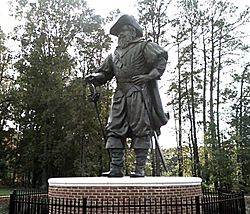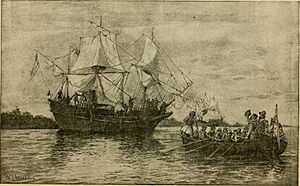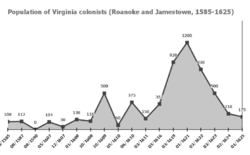Jamestown supply missions facts for kids
The Jamestown supply missions were a series of trips made by ships from England between 1607 and 1611. These missions were organized by the London Company to start and support the English settlement of Jamestown in America. These journeys were very important because they also led to the English settling the island of Bermuda.
The first colonists in Jamestown chose their location because it was easy to defend. However, they were not experienced farmers and the area faced a very bad drought, the worst in 700 years. This made it hard to grow food. The colonists had to rely on trading with Native Americans and getting supplies from England to survive.
Captain Christopher Newport was in charge of the first three supply missions. Later, a fourth mission led by Lord Thomas West finally brought enough supplies and people to make the colony safe and successful.
Contents
The First Voyage to Jamestown
In 1606, the London Company sent three ships to start a new settlement in a part of America they called Virginia. The ships set sail on December 20, 1606, with 105 men and boys. There were no women on this first trip.
The three ships in this first fleet were:
- Discovery, a small ship led by Captain John Ratcliffe.
- Godspeed, a medium-sized ship led by Captain Bartholomew Gosnold.
- Susan Constant, the largest ship, led by Captain Christopher Newport.
A Long Journey
The journey across the Atlantic Ocean was very long, taking 144 days. During the trip, Captain John Smith was accused of causing trouble and was arrested. The captain planned to punish him, but when they arrived, they opened secret orders from the London Company. These orders said that John Smith was to be one of the new colony's leaders, which saved him.
After a long voyage, the ships reached the coast of Virginia on April 26, 1607. They sailed up a river they named the James River. On May 14, they chose a spot on what is now called Jamestown Island to build their fort. They picked this place because it was easy to defend from ships of other countries like Spain.
Life was very hard for the settlers. Their food supplies were low, and a severe drought made it difficult to grow crops. They hoped to find gold and send valuable timber back to England, but they spent most of their time just trying to find enough food to eat. On June 22, 1607, Captain Newport sailed back to England on the Susan Constant and Godspeed, leaving 104 colonists behind with the small ship Discovery.
Searching for Food
John Smith used the small ship Discovery to explore the Chesapeake Bay. He made several trips to trade with different Native American tribes for food. During one trip in December 1607, he was captured by men from the Pamunkey tribe. According to his own story, he was saved by Pocahontas, the daughter of the chief. He returned to Jamestown just as the first supply ship arrived from England.
The First Rescue Mission
When Captain Newport arrived back in London, he told the company that Jamestown needed help right away. He quickly organized a mission to bring more supplies and over 70 new colonists.
The ships were:
- John and Francis, led by Captain Christopher Newport.
- Phoenix, led by Captain Francis Nelson.
The ships arrived on January 2, 1608. Newport was shocked to find that only 38 of the original colonists had survived. The new people and supplies were a great help, but a few days later, a fire destroyed most of the fort, including their homes and food. The colonists became even more dependent on help from England. After helping rebuild, Newport sailed back to England on April 10, 1608.
The Second Supply: Bringing Skills and People
Newport returned to London in May 1608. Even though he hadn't found any real gold, the company organized another supply trip. This time, they sent 70 more settlers, including the first two women to arrive in Jamestown: Mistress Forrest and her maid, Anne Burras.
This mission also brought skilled workers from other parts of Europe, including craftsmen from Poland and Germany. These workers were hired to make products like glass, soap, and lumber that could be sold in England. One of their first projects was building a glass furnace, which became one of the first factories in America.
The supply ship, the Mary Margaret, arrived on October 1, 1608. Captain Newport tried to make the powerful Native American leader, Powhatan, a "sub-king" under the English king, but the ceremony did not go as planned. Newport returned to England with products like glass and tar, but it still wasn't enough to make the colony profitable.
The Third Supply: A Giant Fleet and a Terrible Storm
In 1609, the London Company sent its biggest supply mission yet. It was a fleet of nine ships carrying 500 to 600 people, including women and children, along with livestock and a year's worth of supplies. The flagship of this fleet was a brand-new ship called the Sea Venture. It carried the new governor, Thomas Gates, and other important leaders.
The fleet of nine ships included:
- Blessinge
- Catch
- Diamond
- Faulcon
- Lion
- Sea Venture (the flagship)
- Swallow
- Unitie of London
- Virginia
Shipwrecked in Bermuda!
As the fleet crossed the Atlantic, it was hit by a huge storm, likely a hurricane, that lasted for three days. The ships were all separated. The Sea Venture was badly damaged and began to leak. To save everyone on board, the admiral, George Somers, steered the ship onto the reefs of Bermuda. All 150 passengers and crew made it to the island safely.
For the next nine months, the survivors lived on Bermuda. They found the island had plenty of food, like wild pigs and fruit. Using wood from Bermuda's cedar trees and parts from the wrecked Sea Venture, they built two new, smaller ships: the Deliverance and the Patience.
In May 1610, they finally set sail for Jamestown. When they arrived, they found the colony in ruins. The winter of 1609-1610 had been horrible, a period now known as the "Starving Time". Most of the colonists had died from hunger and sickness. Only 60 survivors remained. The leaders decided there was no choice but to abandon Jamestown and sail back to England.
Lord De La Warr to the Rescue
As the Jamestown survivors were sailing away from the ruined fort, they saw another fleet of ships arriving. It was the "fourth" supply mission, led by a new governor, Lord De La Warr. He had brought 150 new colonists, plenty of food, and supplies.
Lord De La Warr ordered the departing colonists to turn around and return to Jamestown. His arrival on June 9, 1610, was a major turning point. It saved the colony from being abandoned and marked the beginning of a new effort to make Jamestown a success.
Keeping the Colony Alive
Over the next few years, more supply missions continued to arrive. Sir Thomas Dale and Sir Thomas Gates brought hundreds of new settlers, as well as horses, cattle, and other animals. They established strict rules that helped bring order to the colony.
These later missions were crucial for Jamestown's survival. They brought the people, food, and leadership needed to keep the colony going through its most difficult years.
How the Missions Saved Jamestown
The Jamestown supply missions were essential to the survival of England's first permanent colony in North America. Without the constant arrival of new people and supplies, the settlement would have failed during the "Starving Time."
The arrival of Lord De La Warr's fleet in 1610 was the moment that saved Jamestown from being abandoned forever. After this, the colony began to grow stronger. A few years later, one of the Sea Venture survivors, John Rolfe, learned how to grow a popular type of tobacco. This tobacco became a valuable cash crop that could be sold in England, finally giving the colony a way to be successful.







